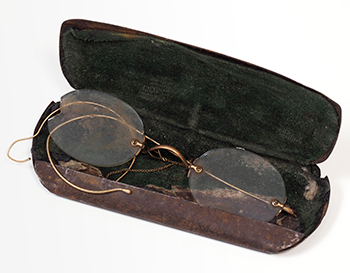Annie Burke’s glasses: a new lens through which to view Bloody Sunday, 1920
Published in Artefacts, Issue 6 (November/December 2020), Volume 28Annie Burke’s glasses: a new lens through which to view Bloody Sunday, 1920
By Siobhán Doyle
 Artefacts that bear visible traces of damage caused by conflict are often employed by curators in exhibitions in order to emphasise the physicalities of violence and the distress of individuals. Many of these artefacts are everyday objects that become extraordinary because of their association with significant events in history. One such artefact is a pair of glasses belonging to Annie Burke.
Artefacts that bear visible traces of damage caused by conflict are often employed by curators in exhibitions in order to emphasise the physicalities of violence and the distress of individuals. Many of these artefacts are everyday objects that become extraordinary because of their association with significant events in history. One such artefact is a pair of glasses belonging to Annie Burke.
Annie attended the Dublin vs Tipperary challenge match on 21 November 1920, which took a dreadful turn when Crown forces entered Croke Park and opened fire on the thousands of spectators. Fourteen people lost their lives and the events of that day marked a turning point in the War of Independence.
Michael Foley’s recently published second edition of The bloodied field: Croke Park, Sunday 21 November 1920 describes how Annie drifted across the field and draped her coat around the body of Michael Hogan, who lay dead on the ground. Annie herself left the field unscathed, apart from a piece of glass that cut her face. Her glasses were damaged by a ricocheting piece of grit and she never wore them again. They were never repaired or cleaned, and they remained in their case in their disfigured condition.
Almost 100 years on from Bloody Sunday, the glasses were donated to the GAA Museum by Sr Margaret Looby. The circulation of the glasses is closely related to the emotional value ascribed to them. This is evident through the processes of keeping them in a private home and passing them down through generations. Bringing them into the public setting of the GAA Museum and inviting them to be viewed by a broader audience marks the phase of transition from individual and private grief to communal commemoration. The donation also reflects a conscious willingness to conserve the memory and legacy of the darkest day in GAA history.
The display of the glasses in the new temporary exhibition in the GAA Museum makes visible in raw, three-dimensional form the effects of the violence of Bloody Sunday and invites viewers to sympathise with those present during the distressing scenes in Croke Park. An important aspect of the glasses is that they survived, as did their owner—a symbol of endurance and a mark of hope in the midst of revolutionary turmoil.
By insisting on the private circulation of and control over artefacts, owners play an important role in how remembrance is manifested through the display of material artefacts. In some cases, the emotional weight and often traumatic nature of personal possessions associated with Bloody Sunday far exceed their economic or research value. For these reasons, many objects associated with the event do not enter the public domain and remain in private family collections. The display of this pair of glasses transforms a private, personal possession of a young Annie Burke into an enduring material testimony to the trauma of Bloody Sunday.
Siobhán Doyle has a Ph.D in Museum Studies, Death and Commemoration, and works in the GAA Museum.
















